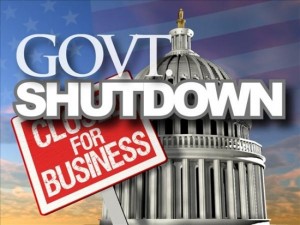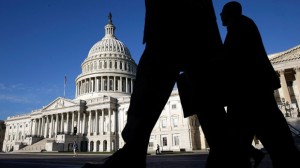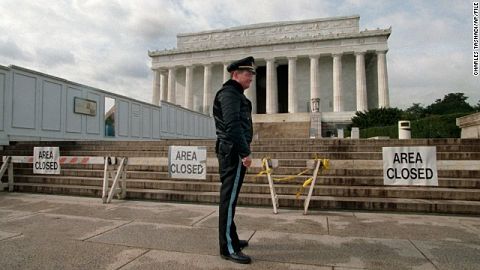World News – Although I did not really want to put anything about this out there as the news has been inundated with both sides of this, I tried to find the most neutral article I could find about the US government shutdown.
 The last 17 government shutdowns in U.S. history all have at least one thing in common: They ended.
The last 17 government shutdowns in U.S. history all have at least one thing in common: They ended.
As the second day of the current shutdown begins, there’s no clear path forward. Republican and Democratic leaders remain entrenched in separate camps, with no serious negotiations ongoing to restart funding to the federal workforce.
But at some point, the impasse must come to an end. Here are five conceivable scenarios for drawing this exercise in Washington dysfunction to a close.
Scenario 1: Republicans fold
In this scenario, at least some House Republicans would abandon their efforts to attach anti-Obamacare provisions to a government spending bill. Those Republicans would partner with House Democrats to amass the 217 votes needed to pass to the “clean,” unamended Senate version of the legislation.
Minority Leader Nancy Pelosi went to the House floor Tuesday to offer Republican Speaker John Boehner enough Democratic votes to pass that Senate bill. Pelosi said she was making “an explicit offer to help you, Mr. Speaker, get those votes because this shutdown, while it might be a joy to all of you who are opposed to government, is a luxury the American people cannot afford.”
The Senate-passed spending bill, or “continuing resolution,” would allow discretionary spending on everything from military training exercises to national monuments through Nov. 15.
If this scenario comes to pass, Boehner’s already shaky leadership could be weakened because conservative House members would be angry that their efforts to delay or defund Obamacare were circumvented, with Democrats providing the votes to end the standoff. They’d question what good it does to be the majority party in the House if the majority can’t achieve its goals.
A deal like this would not by itself solve the bigger and – to many economists – much more frightening problem of whether Congress and President Barack Obama can find a compromise on raising the government’s $16.7 trillion debt limit.
Treasury Secretary Jack Lew says the debt limit will be reached on Oct. 17. With no debt limit agreement, the government would default on some of its debt, and payments to Medicare, Social Security and other beneficiaries would be delayed.
Scenario 2: A short-term deal to fund some agencies
This scenario seems quite unlikely, with an attempt faltering in the House late Tuesday. The House GOP had proposed to fund the operation of most national parks, and Washington, D.C., city government and veterans’ services through Dec. 15. But the vote – which required a two-thirds majority – failed to pass.
Even if it had advanced, the legislation wouldn’t have gotten far.
A White House spokeswoman called them “piecemeal efforts,” and said “the president and the Senate have been clear that they won’t accept this kind of game-playing.” She said Obama would veto them.
Senate Majority Leader Harry Reid, D-Nev., called the Republican effort a “wacky idea” that would simply “cherry-pick some of the few parts of government that they like.” Pelosi said the GOP plan was akin to “releasing one hostage at a time.”
So it’s a scenario based more on hope than reality.
Republicans might try to keep coming up with just the right mix of programs they’d agree to keep funding in the hopes that it would win some Democratic support. If not D.C. government, parks and veterans, they might try another mix: national parks, military readiness and cancer research at the National Institutes of Health.
Keep in mind that the two sides have already taken one major step to limit the impact of the partial government shutdown: Both House and Senate passed a bill to ensure that members of the Armed Forces will keep getting paid during the shutdown.
But that agreement on military pay may have been the easy part. Both sides know that they give up bargaining leverage by agreeing to any of what the opposing side wants.
For Democrats, it’s important to be able to paint the Republicans as the culprits. As Sen. Jeff Flake, R- Ariz., said Tuesday: “The Democrats knew that if there were to be a shutdown, that it would be Republicans who’d take the blame.”
Scenario 3: The impasse lasts for weeks and spending bill negotiations are combined with debt limit negotiations
In this scenario, congressional leaders, having failed to solve the smaller problem of passing a short-term spending bill, decide to raise the stakes by solving both the debt limit and spending in one package deal.
Any hope for a combined package would depend on Republican leaders’ willingness to give up – at least for a while – the leverage they think they get from the recurring fiscal deadlines.
But the odds of a comprehensive deal seem slim. Boehner has already said he wants further spending cuts in return for any increase in the debt limit, while Obama has said again and again that raising the debt limit is a non-negotiable item. The two leaders proved in 2011 that even their most earnest efforts couldn’t bring them to a deal both men could live with.
Scenario 4: The fiscal impasse lasts until the government finally defaults on some of its debt.
In this scenario, the shutdown continues through mid-October when the federal government reaches the end of its legal authority to borrow.
It might be that the shock of a default on the debt ends up being the only thing that gets entrenched Democrats and Republicans to agree on a spending-and-debt accord.
Addressing the chances of the debt limit being reached and a default on Treasury debt, Jeremy Siegel, professor of finance at The Wharton School at the University of Pennsylvania, said on CNBC Tuesday, “The probability is very, very low, but if there is any default or hint of default on U.S. Treasury bonds, there will be chaos in the market.
“If there is any downgrade, if (bond rating agency) S&P decides to go another step and downgrade (U.S. Treasury securities) again, we remember what happened two years ago: 700 points off on the Dow. This is what we need to worry about.”
Scenario 5: A long-term deal that solves bigger fiscal problems
This too seems like an implausible scenario given the high level of acrimony in Congress, but a large – if not “grand” – bargain on a spending bill could include solving a perennial nagging issue: the always-postponed annual cut in reimbursements to doctors who serve Medicare patients. Under a 1997 law, Medicare payments to doctors will be cut by nearly 30 percent unless Congress averts that before the end of the year.
One might throw in another set of bargaining chips like a package of expiring tax provisions.
But to clinch such an ambitious fiscal deal might require concessions from Democrats.
One possible “pay-for” to raise the revenue to solve the Medicare reimbursement problem might be the changes Obama proposed in his Fiscal Year 2014 budget proposal: even more cost-sharing by higher-income beneficiaries enrolled in the Medicare Part B and Part D programs. Liberal Democrats oppose this proposal.
By Tom Curry, National Affairs Writer, NBC News

